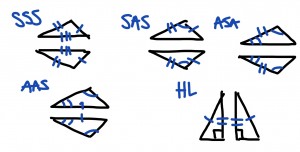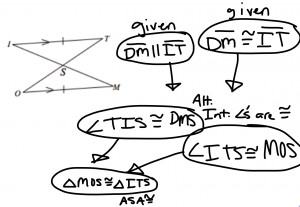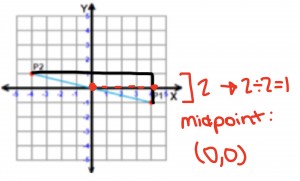Blog 25: ASA and AAS Congruence
When proving triangles congruent the least amount of information needed is an angle measurement, a side length, and another angle measurement or two angle measurements and a side length. AAS or angle, angle, side, is a congruence condition. Another congruence condition is ASA or angle, side, angle. A congruence condition is information that proves two triangles congruent. A triangle needs to have the corresponding parts to another triangle equal to be congruent.
Blog 26: Using Flowcharts
A flowchart is a graphic organizer that organizes your evidence for proving triangles congruent. The triangles are basically set up in bubbles leading to the equal triangles. You start off by writing given information. Next you want to write information that required a method for solving. You always write down the method for solving because that is the purpose of the flowchart, to model work.
Blog 27: Triangle Congruence Conditions
Today we learned about triangle congruence conditions. Triangle congruence conditions are like a way to format your information proving triangles congruent. The congruence conditions are abbreviations, the A’s mean angles and the S’s mean sides. SSS, SAS, and ASA are some examples. When using congruence conditions it is important to make sure the corresponding sides and angles are equal. The order of the congruence condition is how the triangle should be show. What i mean by this is that if you use SAS you need to make sure that a corresponding side, angle, and side are right next to each other.
 Blog 28: Determining a Midpoint
Blog 28: Determining a Midpoint
A midpoint is the exact middle of a line segment. The method i like to use for finding midpoints is quite easy. I start off by graphing the line, if it isn’t already, then i draw a slope triangle. I go to half of the change in the y-axis and follow it until it intersects with my line. This is the easiest method i have found when calculating the midpoint.






Leave a Reply